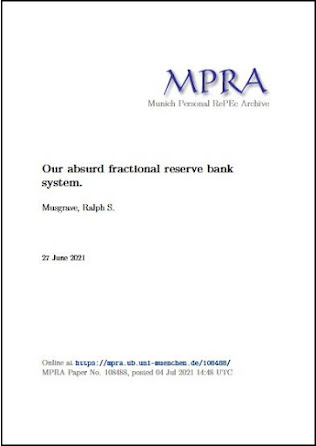The basic objective of bank regulation is to ensure banks are reasonably safe, i.e. that they are unlikely to do a repeat of the 2007/8 bank crisis.
The first questionable aspect of that whole effort is that the chairman of the main UK investigation into banks in the wake of the latter crisis, Sir John Vickers said that regulations are still nowhere near good enough. See article of his article entitled “Storm is coming….”.
But a more fundamental and nonsensical aspect of bank regulation is as follows.
The main element of those regulations consists of trying to ensuring that banks have enough capital to withstand a crisis, i.e. the objective is to ensure they do not take their “borrow short and lend long” activity too far. Borrow short and lend long is also known as “maturity transformation” (MT).
MT is profitable for banks because they can charge a higher rate of interest on “long loans” (e.g. mortgages) than they themselves have to pay to borrow funds short term (e.g. from bog standard bank depositors).
But MT allegedly has a merit, namely that it creates liquidity / money, as pointed out by Messers Diamond and Rajan in the abstract of their NBER working paper No. 7430. So banks and bank regulators spend tens of thousands of hours arguing about how much of a constraint there needs to be in MT to give us reasonable safety without cutting too much into the apparent merit of MT, namely money / liquidity creation.
But wait a moment: it’s not only private / commercial banks that can create money / liquidity. Governments and their central banks (henceforth “the state”) can do that. Indeed, the state can create and issue whatever amount of money is needed to give us full employment! Plus that’s exactly what states have had to do in reaction to the latter crisis and Covid. So why bother with private / commercial banks’ money creation activities at all!
I.e. why not go for TOTAL AND COMPLETE SAFETY by simply banning all money creation by private banks? Put another why not adopt full reserve banking where loans are funded 100% by equity rather than deposits? Moreover, private banks’ money creation efforts are basically just a nuisance: they create and lend out money like there’s no tomorrow in a boom, thus exacerbating booms. Then come a recession, they cut down on the latter activity, or even call in loans: again, exactly what is not wanted.
And that simply increases the amount of counter cyclical activity that states have to engage in.
As the Nobel Laureate economist, Merton Miller, put it reference to and in support of full reserve, “Think how much national economic welfare could rise . . . . . when thousands of no longer needed bank regulators (and hundreds of academic banking economists) find themselves forced at last to seek more socially productive lines of economic activity.”.
For more on the above points, see this recent article of mine.





